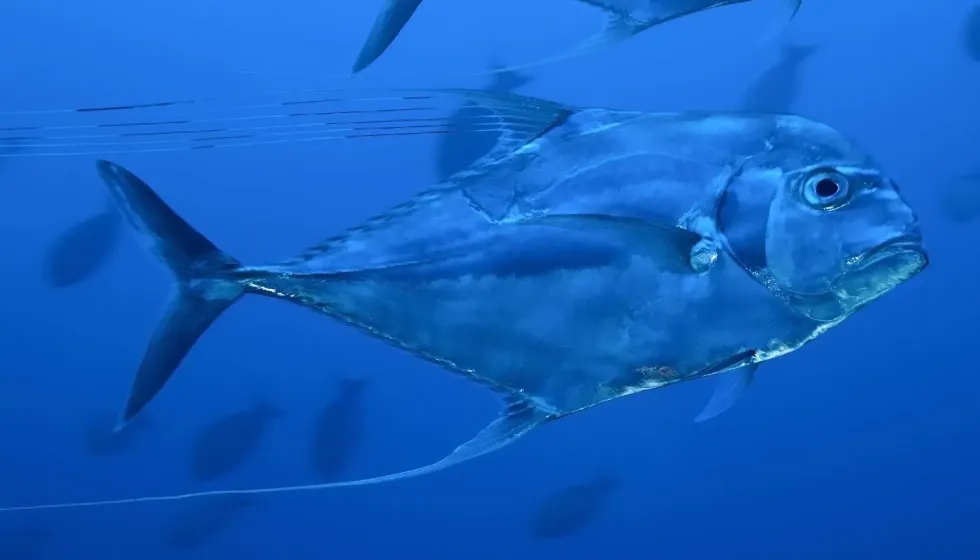The African pompano, Alectis ciliaris, is a fish that is compressed dorsally and laterally and with a head and tail that taper. The curved head of the fish is a strong identifying factor, and this species has four to seven spines that are visible on the dorsal fin.
Found on the coast of tropical waters, the color of this fish is silvery metallic blue to green on top, while the base is mostly silvery.
The African pompano, Alectis ciliaris, is also known as threadfin trevally or the pennant fish and is found in tropical waters. It lives in depths of water that are less than 328.1 ft (100 m) and is a very popular game fish, as it puts up a good fight.
African pompanos have two spines on their anal fin with 15-16 soft rays. These fish have curved yet long dorsal and anal fins.
Though these fish appear scaleless, they have embedded scales that are present all over the body. It is found in South America, East and west of the USA, Africa, the Indian Ocean, and many Pacific Islands.
The main difference between an African pompano and a Florida pompano is in the length of the pectoral fin. It is longer and thinner in the African pompano when compared to Florida pompano.
You may also check out lemon sole facts and Texas cichlid facts from Kidadl.
African Pompano Interesting Facts
What type of animal is an African pompano?
The African pompano, Alectis ciliaris, is a tropical marine fish that belongs to the jack family Carangidae. Jacks have a distinct metallic blue-green silver color and are popular as game fish.
What class of animal does an African pompano belong to?
Pompano African species belong to the Animalia kingdom, class Actinopterygii.
How many African pompanos are there in the world?
There is no record of African pompano species population in the world.
Where does an African pompano live?
The pennant fish habitat range is tropical waters along the coast. It has been found along with the range of Asia, South America, the East and west coastal waters of The USA, and along with certain coast islands in the Pacific Ocean.
In the Gulf of Mexico, the pompanos are found on coasts close to big wrecks, springs, and other deep-water structures, usually 30 miles off the coast.
What is an African pompano's habitat?
African pompano, alectis ciliaris, from the jack family, lives in shallow waters along the coast known to be less than 328.1 ft (100 m) and in small groups called schools. The pennant and dorsal fish of the species can be identified by their distinctive compressed head.
Who does African pompano live with?
African pompanos live on their own.
How long doesana African pompano live?
The lifespan of an African pompano, Alectis ciliaris, is about four years.
How do they reproduce?
African pompanos species lay globular eggs with a yolk and oil bubble to ensure that these eggs with juveniles have buoyancy. The pelagic larvae of the pennant fish have different dorsal fins or rays, head sizes, spines, and pectoral fins. The maximum number of juvenile eggs in the species is found between March and May.
What is their conservation status?
The African pompanos species, also known as the threadfin trevally, has been marked as ‘Least Concern (IUCN3.1). Found in tropical waters and reefs, they are known to be good game fish, as they are hunted for sport. They are also used as a commercial catch in fishing due to their size.
African Pompano Fun Facts
What does African pompano look like?

Alectis ciliaris, also known as the cobbler fish or African pompano or cobblerfish, has a deep compressed body appearance that increases in size as age advances. This species increase in length reduces the depth of the fish that ranges between 88%-38%. They have two spines in their anal fin with 15-16 soft rays.
The threadfin trevally jack juveniles have a striking bluish metallic color with silver at the bottom. The gill has a dark spot on the upper end.
The appearance of the pompano African is further enhanced by the fin rays that are another attractive feature of this fish, with juveniles having long fin rays and dark stripes on the body. The average length is 51.2 in (130 cm).
How cute are they?
The African pompano isn’t a cute fish.
How do they communicate?
African pompanos are mostly on their own and do not communicate with other fish.
How big is an African pompano?
The average length of an African pompano is 51.2 in (130 cm).
How fast can an African pompano fly?
African pompanos do not fly.
How much does an African pompano weigh?
The average weight of an African pompano, Alectis ciliaris, is between 15-20 lb (6.8 - 9.1 kg). The maximum weight record of an African pompano in the world is 50.48 lb (22.9 kg).
What are the male and female names of the species?
African pompanos do not have specific names for males and females.
What would you call a baby African pompano?
An African pompano baby is called a fry.
What do they eat?
The African pompanos usually feed on slow-moving crustaceans and occasionally eat small fishes and crabs.
Are they dangerous?
Even though they are large, African pompanos are not considered to be dangerous. In fact, pompanos are eaten by people too.
Would they make a good pet?
No, since they are big in size, taking care of them would require a lot of maintenance and a big aquarium. So, they won’t make a good pet.
Did you know...
African pompanos are large in size, which makes them attractive as table fare. Apart from the size, the pompano’s meat is buttery and tasty, which has made the African fish popular among commercial as well as recreational fishermen.
When trying to catch an adult African pompano, anglers with conventional fishing gear that has 50lb (22 kg) braid lines may find it ideal. Since they are known to put up a bit of fight, an Accurate BX reel may be needed, and a bit of strength from the anglers to reel the catch in.
The adult African pompano circulates in coastal waters that are shallow and maybe solitary or in small schools. The juveniles are found to move about a lot.
The jack family mimics jellyfish medusae to deter predators from attacking them. Though this is a predator fish, it is prey to larger fish like sharks.
Smaller African pompanos have been caught by anglers using metal jigs, but lures have not always been successful in reeling in adults. The best bait for these fish is the slow trolling baits, as these fish are found in depths of the ocean that are about 197-230 ft (60-70 m) deep.
A strip bait of snappers in Belize may work, or large prawns, or even live baitfish.
As they are attracted to shiny objects, lures that include jigs that are on wrecks or reefs will help in catching them. They are found close to such wrecks, especially in the Gulf of Mexico.
Between the months of February to April, Puerto Vallarta has some schools of these fish, especially a few days before the full moon. Florida has a good number of these fish and may be ideal for a good catch. The legal size of 11 in (27.9 cm) is the limit on Florida pompanos.
The quality and taste of the pompanos depend on the ocean source from where they are wild-caught by the anglers, but they have also been implicated for ciguatera poisoning. In regions where there is a lot of coastal ciguatera poisoning, it is best that such fish species are not caught and are not a part of the table fare.
Usually, larger pompano African have a high level of ciguatera in regions that are high in ciguatera.
The juveniles of African pompanos found in tropical water ocean are visually very attractive and make interesting aquarium fish. Though they have a striking appearance, such fish species do not live long when they are in captivity.
How do you measure an African pompano fish?
African pompanos can be measured based on their length.
What kind of fish is pompano?
African pompanos are mid-sized fish that eat crustaceans and live in warm waters. When eaten, the fish has a firm yet buttery texture, with a fatty taste. They have tasty white meat. The strong flavor produced from the fish makes it ideal in sauces and in marinades. It is a highly expensive fish.
The large head of the Africa pompano Alectis ciliaris also makes it a great addition to curries and in fish stocks. This fish from South America is also rich in Omega 3 fatty acids.
Here at Kidadl, we have carefully created lots of interesting family-friendly animal facts for everyone to discover! For more relatable content, check out these codfish facts and yellow tang facts for kids.
You can even occupy yourself at home by coloring in one of our African Pompano coloring pages.









